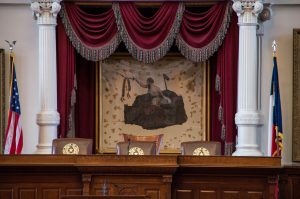Part 10 of our series, “Resilience and Renaissance: Newport, Kentucky, 1795-2020”
By Steve Preston
Special to NKyTribune
General Sidney Sherman was more than a soldier from Newport, Kentucky. He was an innovator in industry, instrumental in bringing new manufacturing practices to Newport and Cincinnati. His impact was crucial to industrialization of the area, helping it to shed its frontier reputation.

Sidney Sherman (Wikimedia Commons photo)
Upon turning sixteen, he moved to Boston where he found employment working as a clerk in a mercantile establishment. He later moved to New York City to start his own business, which ended in failure. Ironically, this failure became Newport’s success.
Sidney Sherman soon relocated to Newport, Kentucky in 1831. He founded a successful cotton bagging business. In his factories, Sherman used a new type of machinery for the assembly of his bags. Innovation was crucial to Sherman’s successful business dealings. He also became the first industrialist west of the Appalachians to manufacture sheet lead. Both these endeavors proved to be a financial windfall for Sherman. His business and financial success made him a well-regarded member of society in both Cincinnati and Newport.
Sherman was also an available bachelor. This situation did not last long.
On April 27, 1835, Sidney Sherman married Catherine Isabel Cox of Frankfort, Kentucky. Their union would produce eight children. Wedded life and time in the social circles of the area would be short. News of the struggle for independence in Texas between Santa Anna and the Anglo-colonists soon made its way back to Kentucky.

The San Jacinto Battle Flag, as displayed in the Texas House of Representatives. (Courtesy of Wikimedia Commons.)
Pleas for funding, material, and fighting men were answered by our region in a mass meeting on November 17, 1835 in Cincinnati, which donated supplies, two cannons nicknamed the “Twin Sisters,” and the services of Sidney Sherman and 51 other volunteers. Known as the “Newport Rifles,” the unit made their way to Texas by steamboat. Sherman and his small force left for Texas on December 29, 1835. They took the supplies, the “Twin Sisters,” and a flag sewn by the ladies of Newport. All four of these would be present at a decisive moment in Texas history.
Arriving in Texas, the force was not called to reinforce the Alamo, which soon tragically fell. Rather, Sherman and the Newport Rifles would find their glory at the Battle of San Jacinto. There, Sherman would lead the Second Regiment. At San Jacinto on April 21, 1836, Sherman and his men, carrying the only flag of the army—their Newport flag—would be the first to utter the battle cry: “Remember the Alamo, Remember Goliad!”
With the “Twin Sisters” firing and Sherman and his men on the left flank, the battle was over in 20 minutes. With the victory over Santa Anna, Texas became independent. Sherman was tasked with returning to Kentucky to recruit more volunteers. He later retired from the Texas military with the rank of general.
Sidney Sherman returned to Texas and settled near the site of the decisive battle. He briefly served in the Texas House of Representatives. He also built a sawmill on his property and invested in land speculation for the coming railroad. The first engine to operate on this line was named the “General Sherman.”
After fire destroyed his mill and home, Sherman moved to Galveston and ran a hotel. Following the outbreak of the American Civil War, Sherman moved his family to his original homestead near the San Jacinto battlefield. He died in Galveston on August 1, 1873.
Steve Preston is the Education Director and a Curator of History at Heritage Village Museum. He received his MA in Public History from Northern Kentucky University.
























